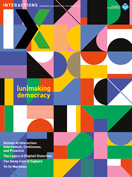Authors:
Interaction Research Studio
Yo-Yo Machines are playful communication devices designed to help people feel socially connected while physically separated. Our response to a U.K. call for projects using previous research to create an impact during the pandemic, YoYo Machines make a long line of work on peripheral and emotional awareness available to the public in the form of devices they can build at home. By following simple online instructions (yoyomachines.io), people can make a pair of devices and send one to a friend or loved one—the devices are connected by the Internet, allowing simple communication at a distance.
 |
Jellyfish and Moon Plate versions of Light Touch. The devices are controlled by capacitive touch, which in these versions are scrunched tinfoil and a bulldog clip. |
Yo-Yo Machines complement Zoom or phone calls by giving a frequent and casual feeling of presence. For instance, Light Touch lets two people send slowly fading colored lights to each other over the Internet. Bill Gaver, co-director of Interaction Research Studio, has been using Light Touch with his 92-year-old mother for approximately nine months. "They're surprisingly compelling—when she sends me a light from California it feels like she's right next to my desk in London," he says. "It's also really nice when I wake up or return home and find a light she's sent earlier, and she says she looks for a light from me particularly when she gets up at night."
Speed Dial is like a mood barometer that people can share with friends or family. Move the pointer to select your choice of message from several options; your partner can respond with theirs. Different dials give different options—use one of ours or make your own; you can be as serious or silly as you want.
Knock Knock lets people send tapping sounds between devices. Knocking on one causes an identical knocking sound on the other, even if it is halfway around the world. Use them to attract attention, say hello, or play elaborate rhythm games. They're a simple and immediate way to connect.
 |
A Speed Dial, made from a cereal box and controlled with a spoon. It features a dial wheel with the seven deadly sins. |
Flutter By are gentle communicators that use motion sensors to pick up activity in one place and signal it in another—like curtains moving when someone walks by them. There are no buttons to operate them; just turn them on and they'll create a sense of connection no matter the distance.
Based on the low-cost ESP32S microcontroller, Yo-Yo Machines are around £25 a pair and easy to make, requiring only a small breadboard, jumper leads, and design-specific actuators. Each enclosure is designed to be constructed from everyday household materials, without the need for any specialized tools. We created comprehensive step-by-step instructions using the Dozuki Web platform to guide even the most novice maker through the build. We also developed easy-to-install software by creating a firmware uploader that manages the boot-loading process. In addition, a dedicated captive portal manages WiFi credentials for both the host device and, if necessary, the remote device, allowing a pair to be constructed in one space and the remote unit to be mailed so that it will connect straight out of the box.
 |
Paired Speed Dials. Users can mix and match the suggested enclosure designs, or create their own. |
The project builds on at least 30 years of research into systems that support peripheral and emotional awareness remotely (see www.yoyomachines.io/history). Numerous designs for simple communication devices have been suggested during that time, but with a few notable exceptions few have actually been implemented to work over a distance, and even fewer have been used by people in their everyday lives. With the advent of inexpensive and powerful microprocessor technologies, and within the context of physical distancing necessitated by the pandemic, Yo-Yo Machines are affordable devices that people can make and use in their own homes to feel connected with one another.
 |
A mini Speed Dial with postcard-size dials that can be easily swapped in coordination with the remote user. |
 |
Knock Knock variations. The device is constructed using a piezo sensor and a small solenoid, which allows housings to be built from a variety of materials ranging from smartphone boxes to jam jars. |
 |
Bill's mother with her Light Touch in California. |
The Interaction Research Studio uses design-led methodologies to explore innovative technologies for everyday life. Their practice-based research integrates design-led research methods with work on embedded and ubiquitous technologies to produce prototype products embodying new concepts for interaction. The studio's designs focus on creating situations rather than solving problems, encouraging playfulness, exploration, and insight in a wide variety of domains.
The team are: Bill Gaver (director), Andy Boucher (director), Dean Brown, David Chatting, Naho Matsuda, Jen Molinera, Liliana Ovalle, Andy Sheen, and Mike Vanis. [email protected]
Copyright held by authors
The Digital Library is published by the Association for Computing Machinery. Copyright © 2021 ACM, Inc.










Post Comment
No Comments Found